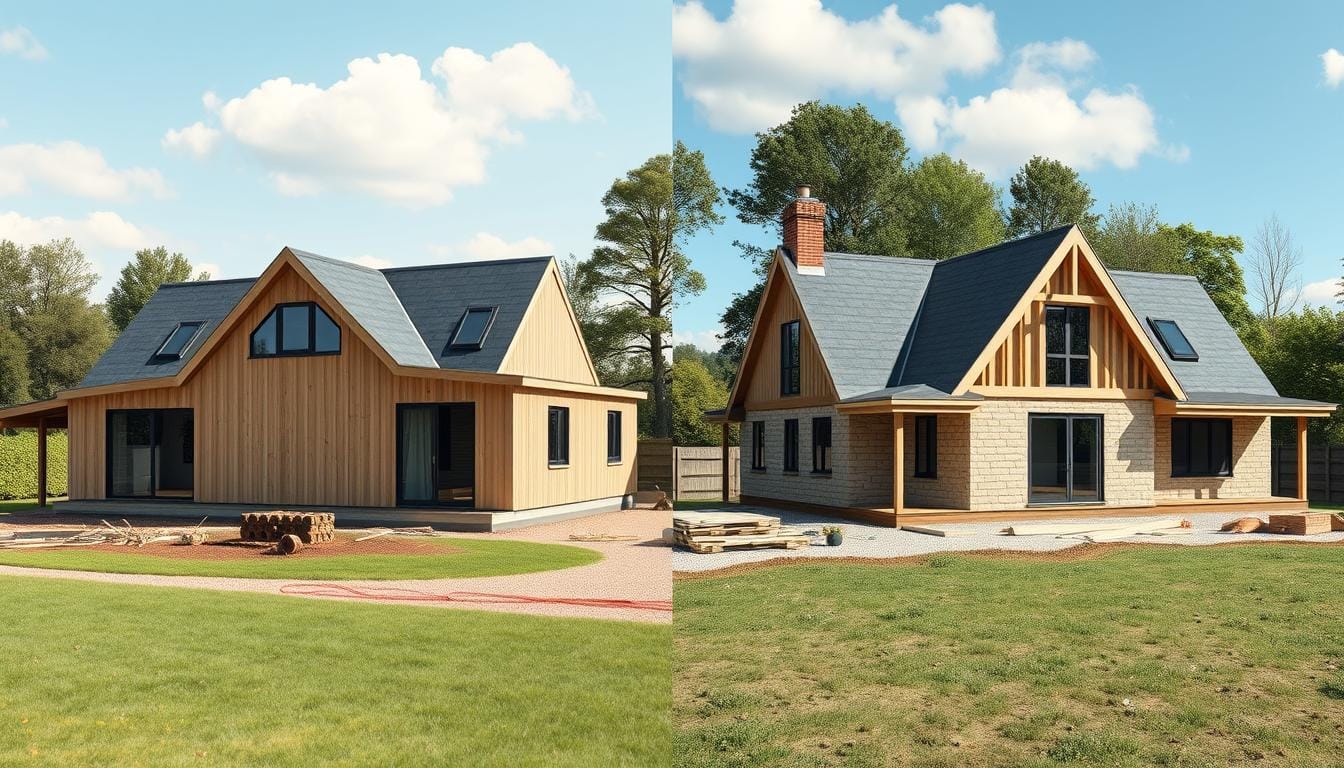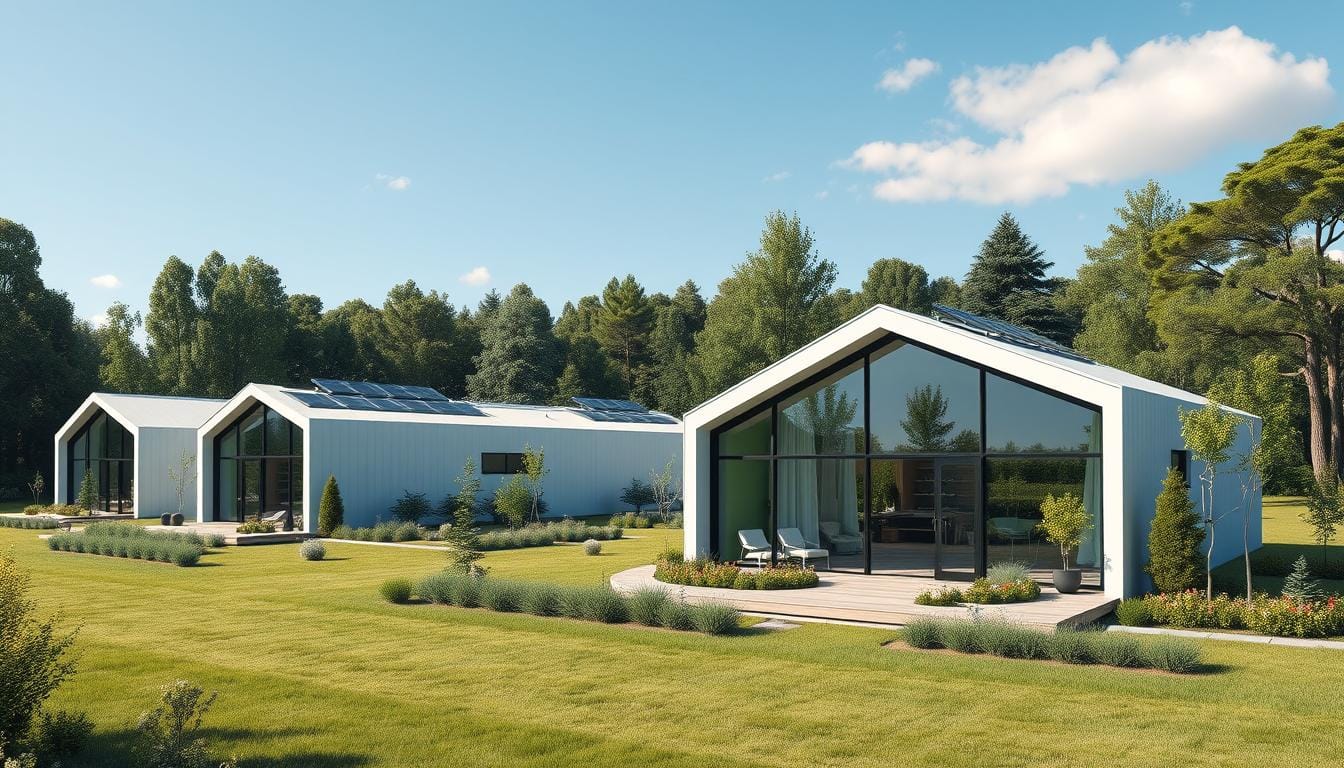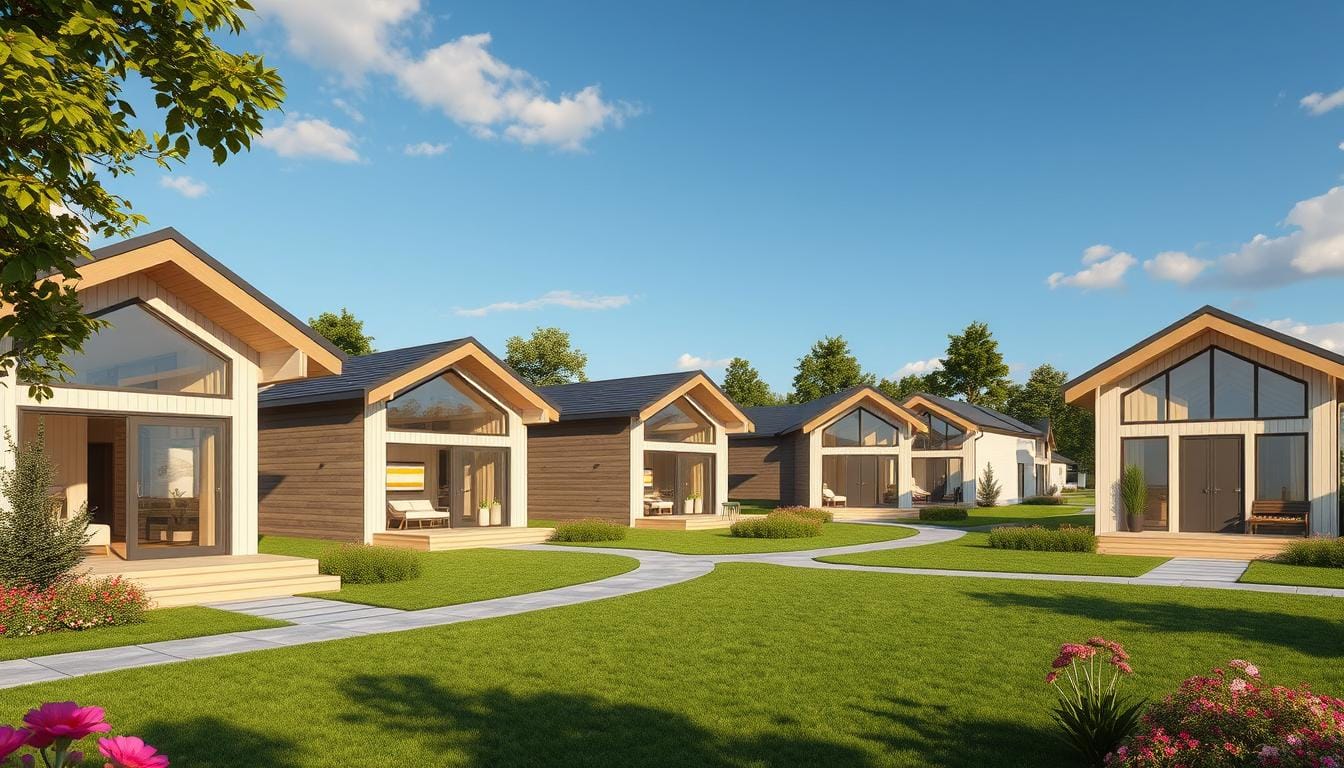When looking at modular home costs versus stick built home expenses, UK homeowners face many choices. Both methods have their own pros and cons. We’ll explore these in detail to help you understand the differences.
This comparison aims to guide you in deciding which method is best for building a home in the UK. It’s all about making the right choice for your needs and budget.
Key Takeaways
- Modular homes generally cost 20% less than stick-built homes.
- Modular home costs: $130-$145 per square foot.
- Stick built home expenses: $210 per square foot.
- Modular homes can be built in 3-4 months, whereas stick-built homes often take longer.
- Up-front costs are typically lower for modular homes compared to stick-built homes.
- Stick-built home construction costs can fluctuate more than modular homes.
Understanding Modular Homes and Stick-Built Homes
Exploring home construction types, it’s key to know the differences between modular and stick-built homes. Each has its own benefits and challenges, fitting different needs and tastes in the housing market.
Definition of Modular Homes
Modular homes are built in a factory and then moved to the site for assembly. This approach cuts costs and speeds up building. They meet local building codes and are durable in extreme weather. Plus, they offer custom designs to suit individual needs.

Definition of Stick-Built Homes
Stick-built homes are built on-site using traditional UK methods. They are built frame by frame, which can be more expensive and prone to delays. They are known for their customisation, allowing homeowners to add unique design elements.
Modular homes are cheaper to build, saving 10 to 35 percent compared to stick-built homes. But stick-built homes offer more design freedom, making them ideal for those who value customisation.
Knowing the differences helps homeowners make better choices. They can pick the construction method that fits their budget, design preferences, and timeline. This knowledge helps them find the right home for their needs.
Cost Breakdown of Modular Homes
Understanding the cost of modular homes is key for those interested. We’ll look at the upfront costs and the long-term savings. This will help us see how modular homes compare to traditional homes.

Initial Expenses
The cost of a modular home varies. It usually starts at $50 to $100 per square foot. This includes the cost of materials and labour in the factory. But, there are other costs too:
- Site preparation can cost between £10,000 to £50,000 or more, depending on the site.
- Utility connections add £5,000 to £30,000, based on the distance and complexity.
- Permit and inspection fees are £1,000 to £5,000.
Despite these costs, modular homes are often more affordable. They save money because of standardised production and controlled environments. Modular homes cost around £100 to £130 per square foot, which is less than traditional homes.
Long-Term Savings
Modular homes offer long-term benefits. They are built to be energy-efficient, which means lower bills. They also need less maintenance, thanks to their quality construction.
Another advantage is the savings on interest. Modular homes are built faster, in 3.5 – 4 months, compared to 5 – 6 months for traditional homes. This can lead to lower interest costs, making modular homes a smart choice.
In summary, modular homes have clear benefits. They have manageable upfront costs and offer significant savings in the long run. Their efficient production, lower maintenance, and energy costs make them a cost-effective option.
Cost Breakdown of Stick-Built Homes
Understanding the cost of stick-built homes is complex. These costs cover everything from the start to the end. Let’s look at the main parts.
Construction Costs
Building a stick-built home is a big investment. It takes a lot of time, often 6 months to 2 years. The cost depends on where you are, the weather, and any delays. Here are the main costs:
- Materials: Good materials make the home last longer and look better, but they cost more.
- Labour: Skilled workers are needed for each step, making the job harder and more expensive.
- Customisation: Stick-built homes can be made just how you want them, but this takes more time and money.

Stick-built homes are very popular, making up 97% of new single-family homes. They offer lots of custom options, but this means they cost more and take longer to build than modular homes.
Maintenance Costs
After you buy a stick-built home, you’ll also have to think about maintenance costs. These homes need regular care because of the weather and wear and tear. Here are some things you might need to do:
- Roofing and Siding: Fixing damage from the weather can be expensive.
- Foundation and Structural Integrity: Checking and fixing the foundation and structure is important for safety and durability.
- Utilities and Systems: Keeping the HVAC, plumbing, and electrical systems working well is key to saving energy and money.
In the long run, the maintenance costs for stick-built homes can add up. They might be higher than for modular homes, which are often more energy-efficient and need less upkeep. So, while building a stick-built home might seem worth it for the custom features, remember the ongoing maintenance costs.
Comparing Construction Times
Looking at how fast homes are built, modular vs. stick-built timings show a big difference. Modular homes are built quickly, thanks to their efficient construction method.
Speed of Installation
Modular homes are made in a factory, where everything is ready to go. This means homes can be built in just 3-4 months. Stick-built homes, on the other hand, can take much longer because of weather and labour delays.
Modular homes are not only faster but also cause less disruption. They offer a quicker way to own a home. For more on this, click here to read about modular and traditional building.

Impact on Cost
Modular homes save money because they’re built quickly. This means less time and money spent on labour. In places like Australia, where labour costs are high, this is a big advantage.
Modular homes also save on waste and emissions, leading to long-term savings. They are a cost-effective and sustainable choice compared to traditional homes. For more on the cost and time benefits, visit our blog on modular vs. traditional construction.
Financial Considerations for Homebuyers
When buying a home in the UK, it’s key to look at financing and resale value. Knowing these can make buying a home easier and more financially wise.
Financing Options
Financing for modular and stick-built homes is similar. Buyers can get home financing UK through various mortgage products. For example, construction-to-permanent loans finance both the home’s construction and land purchase, turning into a regular mortgage when done.
Strategic Mortgage Solutions offers tailored options for modular homebuyers. Modular homes are also cheaper per square foot. This can mean lower borrowing amounts and smaller monthly payments.
Resale Value Factors
Resale value is a big consideration for buyers. Modular homes might start at lower prices than stick-built ones. But, as quality and perception improve, the gap narrows.
Quality materials, building codes, and location affect modular home resale values. In strong housing markets, the price difference between modular and stick-built homes may be small. Plus, modern modular homes are built to last, matching traditional homes in value and durability.
In summary, buying a home in the UK, whether modular or stick-built, needs a deep look at mortgages and resale values. Good market research and financial planning help buyers make smart choices. This ensures both affordability now and value in the future.




